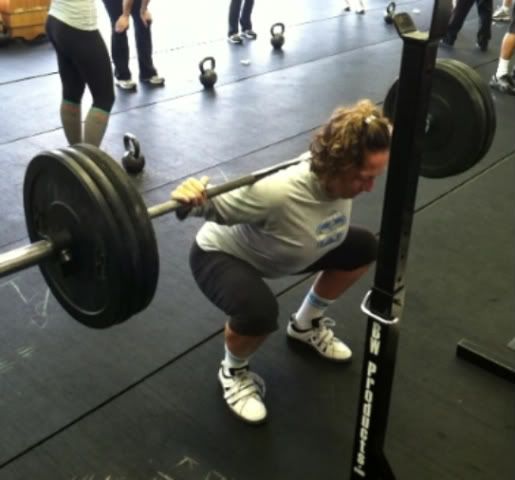Muscle Spindle
/ Shea shows great position and depth here at the bottom of her back squat. Why do we ask you to get your hip crease below your knee when squatting? One very important reason is the utilization of the stretch reflex of the hamstrings, which is optimally activated when squatting at depth. The stretch reflex is generated by the muscle spindle, a proprioceptive organ loctated within the belly of the muscle. Muscle spindles respond to or are stimulated by a stretch. Stimulation of the muscle spindle produces a signal to be sent out through the spinal cord and right back to the very muscle (hamstring) the muscle spindle is within, producing a more forceful contraction of that muscle. Muscle spindles are sensitive to the rate and magnitude of the stretch. The magnitude of stretch in the case of the back squat refers to the depth at which you squat. If the squat is above parallel, the muscle spindle will not be adequately stimulated, decreasing the force production of the hamstrings.The stretch reflex is an involuntary response to a stretched muscle, we cannot call on it to add force to any movement. There must be a stretch immediately followed by a concentric contraction. If there is too much time between the stretch and the concentric phase (staying at the bottom of the squat for a second or two) the stretch reflex is negated.
Similar to the stretch reflex is the series elastic component of musculotendinosous tissue. These two phenomenon’ make up what is known as the stretch shortening cycle, which we’ll save for next time (real cliffhanger huh).
Shea shows great position and depth here at the bottom of her back squat. Why do we ask you to get your hip crease below your knee when squatting? One very important reason is the utilization of the stretch reflex of the hamstrings, which is optimally activated when squatting at depth. The stretch reflex is generated by the muscle spindle, a proprioceptive organ loctated within the belly of the muscle. Muscle spindles respond to or are stimulated by a stretch. Stimulation of the muscle spindle produces a signal to be sent out through the spinal cord and right back to the very muscle (hamstring) the muscle spindle is within, producing a more forceful contraction of that muscle. Muscle spindles are sensitive to the rate and magnitude of the stretch. The magnitude of stretch in the case of the back squat refers to the depth at which you squat. If the squat is above parallel, the muscle spindle will not be adequately stimulated, decreasing the force production of the hamstrings.The stretch reflex is an involuntary response to a stretched muscle, we cannot call on it to add force to any movement. There must be a stretch immediately followed by a concentric contraction. If there is too much time between the stretch and the concentric phase (staying at the bottom of the squat for a second or two) the stretch reflex is negated.
Similar to the stretch reflex is the series elastic component of musculotendinosous tissue. These two phenomenon’ make up what is known as the stretch shortening cycle, which we’ll save for next time (real cliffhanger huh).
Workout:


